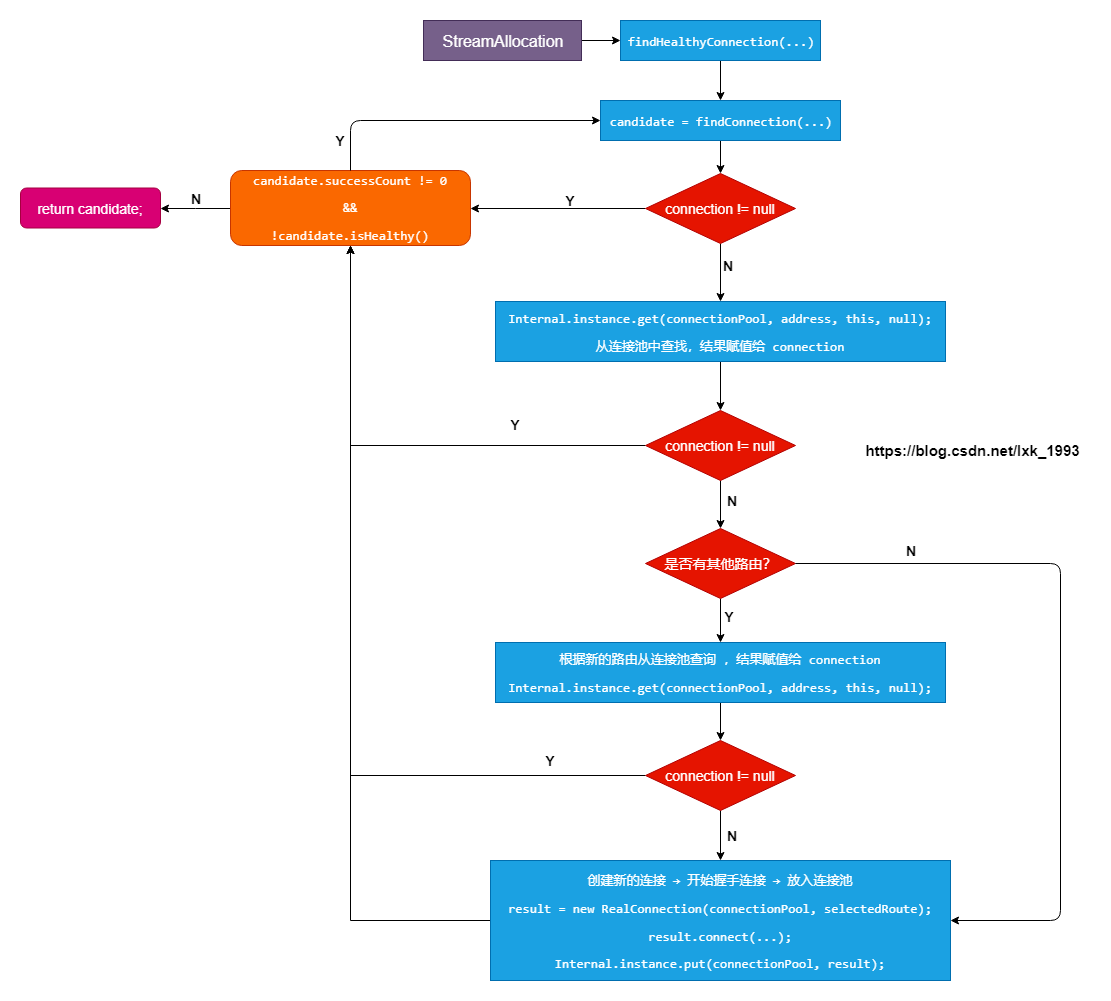okhttp之StreamAllocation
转载请以链接形式标明出处: 本文出自:103style的博客
base on 3.12.0
目录
- 背景
- 简介
StreamAllocation的成员变量StreamAllocation的构造函数StreamAllocation的相关方法- 小结
背景
HTTP 的版本从最初的 1.0版本,到后续的 1.1版本,再到后续的 google 推出的SPDY,后来再推出 2.0版本,HTTP协议越来越完善。okhttp也是根据2.0和1.1/1.0作为区分,实现了两种连接机制.
http2.0解决了老版本(1.1和1.0)最重要两个问题:
- 连接无法复用
- head of line blocking (HOL)问题
http2.0 使用 多路复用 的技术,多个 stream 可以共用一个 socket 连接。每个 tcp连接都是通过一个 socket 来完成的,socket 对应一个 host 和 port,如果有多个stream(即多个 Request) 都是连接在一个 host 和 port上,那么它们就可以共同使用同一个 socket ,这样做的好处就是 可以减少TCP的一个三次握手的时间。
在OKHttp里面,负责连接的是 RealConnection 。
简介
官方注释是
StreamAllocation是用来协调Connections、Streams和Calls这三个实体的。
HTTP通信 执行 网络请求Call 需要在 连接Connection 上建立一个新的 流Stream,我们将 StreamAllocation 称之 流 的桥梁,它负责为一次 请求 寻找 连接 并建立 流,从而完成远程通信。
然后我们先来看看 StreamAllocation 这个类是在什么地方初始化的,以及在哪些地方用到?
选中StreamAllocation 的构造方法,在 AndroidStudio 中按 Alt + F7,我们发现是在 RetryAndFollowUpInterceptor这个拦截器intercept(Chain chain)中创建的.
然后往下层拦截器传递,直到 ConnectInterceptor 以及 CallServerInterceptor才继续用到。
public final class RetryAndFollowUpInterceptor implements Interceptor {
...
@Override public Response intercept(Chain chain) throws IOException {
...
StreamAllocation streamAllocation = new StreamAllocation(client.connectionPool(),
createAddress(request.url()), call, eventListener, callStackTrace);
...
}
public final class ConnectInterceptor implements Interceptor {
...
@Override public Response intercept(Chain chain) throws IOException {
...
HttpCodec httpCodec = streamAllocation.newStream(client, chain, doExtensiveHealthChecks);
RealConnection connection = streamAllocation.connection();
return realChain.proceed(request, streamAllocation, httpCodec, connection);
}
}
public final class CallServerInterceptor implements Interceptor {
...
@Override public Response intercept(Chain chain) throws IOException {
...
streamAllocation.noNewStreams();
...
}
...
}StreamAllocation 的成员变量
- 由构造方法中传入的变量:
public final Address address;地址private final ConnectionPool connectionPool;连接池public final Call call;请求对象public final EventListener eventListener;事件回调private final Object callStackTrace;日志private final RouteSelector routeSelector;路由选择器
private RouteSelector.Selection routeSelection;选中的路由集合private Route route;路由private RealConnection connection;HTTP连接private HttpCodec codec;HTTP请求的编码和响应的解码
StreamAllocation 的构造函数
在 RetryAndFollowUpInterceptor 中传入了 :
- OkHttpClient 配置的 连接池.
- 根据 Request 构建了
Address. - 构建的 RealCall 对象.
- OkHttpClient 配置的
eventListener. - RealCall 中
captureCallStackTrace()中配置的callStackTrace - 根据相关参数构建的
RouteSelector.
public StreamAllocation(ConnectionPool connectionPool, Address address, Call call,
EventListener eventListener, Object callStackTrace) {
this.connectionPool = connectionPool;
this.address = address;
this.call = call;
this.eventListener = eventListener;
this.routeSelector = new RouteSelector(address, routeDatabase(), call, eventListener);
this.callStackTrace = callStackTrace;
}StreamAllocation 的相关方法
我们在简介中介绍 StreamAllocation 在哪里创建的时候,发现拦截器中主要调用的就是 newStream(...) 和 noNewStreams() 这两个方法。那我们先来看看这两个方法吧。
newStream(...)
主要就是获取一个 可用的连接 和 对应连接协议的编解码实例,并赋值给变量 connection 和 codec.
public HttpCodec newStream(...) {
...
try {
//在连接池中找到一个可用的连接 没有则创建一个
RealConnection resultConnection = findHealthyConnection(connectTimeout, readTimeout,
writeTimeout, pingIntervalMillis, connectionRetryEnabled, doExtensiveHealthChecks);
//获取对应协议的 编解码类 Http1Codec or Http2Codec
HttpCodec resultCodec = resultConnection.newCodec(client, chain, this);
synchronized (connectionPool) {
codec = resultCodec;
return resultCodec;
}
} catch (IOException e) {
throw new RouteException(e);
}
}noNewStreams()
主要就是设置当前的 connection 不能再创建新的流。
public void noNewStreams() {
Socket socket;
Connection releasedConnection;
synchronized (connectionPool) {
releasedConnection = connection;
socket = deallocate(true, false, false);
if (connection != null) releasedConnection = null;
}
closeQuietly(socket);
if (releasedConnection != null) {
eventListener.connectionReleased(call, releasedConnection);
}
}继续看下 newStream(...) 获取可用连接的流程。
findHealthyConnection(...)
通过findConnection(...)得到一个连接,如果是新创建的连接,则直接返回,否则检查 连接 是否已经可以开始承载新的流,不行则继续findConnection(...).
private RealConnection findHealthyConnection(...) throws IOException {
while (true) {
RealConnection candidate = findConnection(...);
//如果是一个新创建的连接 则直接返回
synchronized (connectionPool) {
if (candidate.successCount == 0) {
return candidate;
}
}
//否则检查 连接 是否已经可以开始承载新的流
if (!candidate.isHealthy(doExtensiveHealthChecks)) {
noNewStreams();
continue;
}
return candidate;
}
}findConnection(...)
1.0第一个synchronized (connectionPool)这一段首先尝试使用当前的变量connection. 如果当前的connection为null, 则通过Internal.instance.get(connectionPool, address, this, null);在 连接池 中获取对应address的连接 赋值给connection,如果当前的connection不为null,则直接返回.2.0如果上一步没有找到可用连接,则看是否有其他可用路由。3.0第二个synchronized (connectionPool)这一段,3.1如果有其他路由则先去连接池查询看是否有对应连接,3.2没有的话则创建一个新的 RealConnection,并赋值给变量connection.3.3在连接池中找到的话则直接返回。4.0然后新创建的连接开始握手连接,然后放入连接池,然后返回。
private RealConnection findConnection(...) throws IOException {
...
//1.0 尝试使用当前的 connection,或者查找 连接池
synchronized (connectionPool) {
...
releasedConnection = this.connection;
if (this.connection != null) {
result = this.connection;
releasedConnection = null;
}
if (!reportedAcquired) {
releasedConnection = null;
}
if (result == null) {
Internal.instance.get(connectionPool, address, this, null);
if (connection != null) {
foundPooledConnection = true;
result = connection;
} else {
selectedRoute = route;
}
}
}
...
if (result != null) {
return result;
}
//2.0 看是否有其他的路由
boolean newRouteSelection = false;
if (selectedRoute == null && (routeSelection == null || !routeSelection.hasNext())) {
newRouteSelection = true;
routeSelection = routeSelector.next();
}
//3.0
synchronized (connectionPool) {
if (newRouteSelection) {
//3.1 有其他路由则先去连接池查询看是否有对应连接
}
if (!foundPooledConnection) {
...
//3.2 没有的话则创建一个新的RealConnection,并赋值给变量 connection
result = new RealConnection(connectionPool, selectedRoute);
acquire(result, false);
}
}
// 3.3 在连接池中找到的话则直接返回
if (foundPooledConnection) {
eventListener.connectionAcquired(call, result);
return result;
}
//4.0 新创建的连接开始握手连接
result.connect(...);
synchronized (connectionPool) {
reportedAcquired = true;
Internal.instance.put(connectionPool, result);
...
}
...
return result;
}流程图大概如下:

acquire(...)从连接池找到对应连接 赋值给StreamAllocation
public void acquire(RealConnection connection, boolean reportedAcquired) {
assert (Thread.holdsLock(connectionPool));
if (this.connection != null) throw new IllegalStateException();
this.connection = connection;
this.reportedAcquired = reportedAcquired;
connection.allocations.add(new StreamAllocationReference(this, callStackTrace));
}获取成员变量的一些方法.
public HttpCodec codec() {
synchronized (connectionPool) {
return codec;
}
}
public Route route() {
return route;
}
public synchronized RealConnection connection() {
return connection;
}release() 资源释放
public void release() {
Socket socket;
Connection releasedConnection;
synchronized (connectionPool) {
releasedConnection = connection;
socket = deallocate(false, true, false);
if (connection != null) releasedConnection = null;
}
closeQuietly(socket);
if (releasedConnection != null) {
Internal.instance.timeoutExit(call, null);
eventListener.connectionReleased(call, releasedConnection);
eventListener.callEnd(call);
}
}小结
- 介绍了
HTTP2和HTTP1的区别,HTTP2使用 多路复用 的技术,减少了同地址的TCP握手时间。 - 介绍了
StreamAllocation的主要方法newStream(...),以及其中获取可用Connection的具体逻辑. -
newStream(...)返回的HttpCodec这个 编解码的示例后面也会介绍。
参考文章
如果觉得不错的话,请帮忙点个赞。
以上
